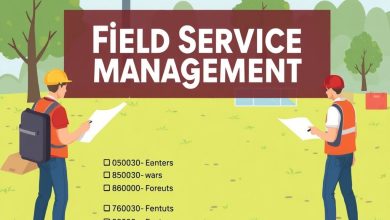Field Service Management with PPE Checklists Enhancing Safety and Efficiency

Field Service Management with PPE Checklists
- Introduction
- The Importance of PPE in Field Service Management
- Implementing PPE Checklists in Field Service Management
- Create Comprehensive Checklists
- Train Employees on Proper Usage
- Conduct Regular Inspections
- Integrate Checklists into Mobile Apps
- Make Checklists Accessible Offline
- Automate Assignments
- Track Compliance
- Emerging Technologies in FSM PPE Management
- Augmented Reality (AR) Training
- Wearable Technology Sensors
- AI-Powered Predictive Maintenance
- Blockchain for Supply Chain Transparency
- Conclusion
Introduction
Field service management (FSM) is a critical component of many industries, including construction, utilities, and home maintenance. It involves coordinating and managing tasks performed outside of a traditional office environment. In recent years, there has been a growing emphasis on safety protocols within FSM, particularly when it comes to personal protective equipment (PPE) checklists.
Personal protective equipment refers to specialized gear designed to protect workers from various hazards encountered during job site operations. Common examples of PPE include hard hats, safety glasses, gloves, and respirators. While PPE has long been a standard part of workplace safety practices, its implementation and enforcement have become increasingly sophisticated in modern FSM systems.
This article will explore the intersection of field service management and PPE checklists, examining how these two concepts work together to create safer, more efficient work environments. We’ll discuss the importance of PPE in FSM, best practices for implementing PPE checklists, and emerging technologies that are revolutionizing the way FSM companies manage safety protocols.
The Importance of PPE in Field Service Management
Personal protective equipment plays a crucial role in maintaining worker safety across various industries. In field service management, where employees often work in unpredictable environments, proper use of PPE can mean the difference between life and death.
Some key reasons why PPE is essential in FSM include:
- Protection against physical hazards: Hard hats, steel-toed boots, and high-visibility vests help prevent injuries from falling objects, heavy machinery, and vehicle collisions.
- Prevention of chemical exposure: Respirators and chemical-resistant suits safeguard workers from toxic substances found in industrial settings.
- Shielding from biological threats: Face masks and eye protection defend against airborne pathogens and bodily fluids.
- Mitigation of ergonomic risks: Proper footwear and back support devices reduce the risk of musculoskeletal disorders associated with repetitive movements and heavy lifting.
By incorporating PPE checklists into their FSM processes, companies can significantly reduce the number of workplace accidents and ensure compliance with regulatory standards. This not only protects employees but also helps maintain a positive public image and avoid costly legal liabilities.
Implementing PPE Checklists in Field Service Management
Implementing effective PPE checklists is crucial for ensuring consistent adherence to safety protocols across all job sites. Here are some best practices for integrating PPE checklists into FSM operations:
Create Comprehensive Checklists
Develop detailed PPE checklists that cover all potential hazards associated with specific jobs. These should be tailored to the particular industry and task at hand. For example, a checklist for electrical work might include items like insulated gloves, safety glasses, and arc-rated clothing, while a checklist for plumbing repairs might focus on slip-resistant footwear and knee pads.
Train Employees on Proper Usage
Provide thorough training sessions on the correct usage and maintenance of PPE. This includes explaining the purpose of each item, how to properly fit and adjust equipment, and what to do in case of emergencies.
Conduct Regular Inspections
Regularly inspect PPE to ensure it remains in good condition. Damaged or ill-fitting equipment should be replaced immediately to maintain its effectiveness.
Integrate Checklists into Mobile Apps
Utilize mobile applications specifically designed for FSM to streamline the process of creating, assigning, and tracking PPE checklists. These apps allow supervisors to monitor real-time compliance and provide instant feedback to workers.
Make Checklists Accessible Offline
Ensure that PPE checklists are accessible even without an internet connection. This allows workers to refer to them in remote areas or during power outages.
Automate Assignments
Use FSM software to automatically assign appropriate PPE checklists based on job type, location, and weather conditions. This ensures that workers always have the right equipment for the task at hand.
Track Compliance
Implement a system to track employee compliance with PPE checklists. This data can be used to identify trends, improve safety procedures, and recognize top-performing teams.
Emerging Technologies in FSM PPE Management
The field of field service management is rapidly evolving, with technological advancements playing a significant role in improving safety protocols. Some cutting-edge solutions include:
Augmented Reality (AR) Training
AR technology is being used to create immersive training simulations for PPE usage. These virtual environments allow workers to practice donning and using PPE in realistic scenarios before encountering actual hazards.
Wearable Technology Sensors
Smart sensors embedded in PPE can detect environmental factors such as temperature, humidity, and gas levels. When thresholds are exceeded, the device alerts the worker to put on appropriate protective gear.
AI-Powered Predictive Maintenance
Artificial intelligence algorithms analyze historical data and current conditions to predict when PPE may need replacement or maintenance. This proactive approach helps ensure that workers always have functioning equipment available.
Blockchain for Supply Chain Transparency
Blockchain technology is being explored to create transparent supply chains for PPE. This ensures that equipment is genuine, properly maintained, and traceable throughout its lifecycle.
Conclusion
Field service management and PPE checklists are intertwined aspects of modern workplace safety. By implementing robust PPE protocols and leveraging innovative technologies, FSM companies can significantly enhance worker safety while optimizing operational efficiency.
As the field continues to evolve, it’s crucial for managers to stay informed about the latest developments in FSM technology and safety best practices. By doing so, they can create safer, more productive work environments that benefit both employees and the organization as a whole.
Remember, safety is paramount in any field service operation. By prioritizing PPE checklists and embracing cutting-edge technologies, FSM professionals can build a culture of safety that protects workers, maintains compliance, and drives business success.




